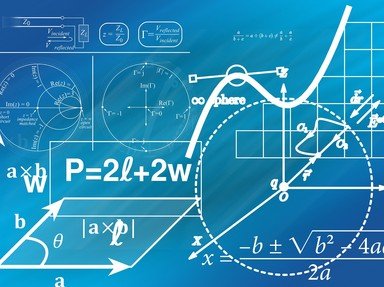Quiz Answer Key and Fun Facts
1. This number is one of the most recognizable constants in the world, used in mainly in determining properties of circles. Competitions exist around the world for people who have memorized this number to a certain number of decimal places. In mathematical equations this number is represented by π.
2. The value e or Euler's number, is another famous Transcendental number with an approximate value of 2.71828. This number can be represented in many ways mathematically; which below is NOT a way of expressing e?
3. The golden ratio, represented by the Greek letter Phi, is defined as the ratio where a+b is to a as a is to b. The golden ratio is used in spirals, golden rectangles and many other real world applications. This value is approximately what?
4. This "number" is famous for being imaginary, meaning there is no numeral value that can be expressed simply for this number. It is exactly equal to the square root of -1. What letter expresses this imaginary value?
5. Different from e (Euler's number), Euler's constant, represented by the Greek letter Gamma, still has many unknown properties for mathematicians. Which of these has been known about Euler's constant prior to the 21st century?
6. Ramsey numbers are the numbers of vertexes on a K(n) where R(x,y) will have x connecting lines of colour 1 and y connecting lines of colour 2 in a two colour colouring scheme. For R(3,3) the Ramsey number is 6. During Ramsey's lifetime only a few of his namesake numbers were ever proved. What is the highest Ramsey number calculated during Ramsey's lifetime?
7. This man first proved the existence of transcendental numbers in 1844 with his namesake constant, represented by the limit of 10^(-k) as k approaches infinity. This number is a decimal with ones in the n-th digit where n is a value of k!, with all other digits being 0, eg. 0.110001000 etc.
8. This ratio is similar to the golden ratio in that it defines not the limiting ratio of Fibonacci numbers like the golden ratio but the limiting ratio of consecutive Pell numbers. It is defined as the ratio where 2a+b is to a as a is to b. What is this number, named after the similar Golden ratio?
9. Gauss's constant, used in math, defined as the reciprocal of the arithmetic-geometric mean of 1 and the square root of 2, is the same value as Gauss's gravitational constant, used in physics and astronomy, which is used to predict planetary orbit.
10. The Erdős-Borwein constant is defined as the sum, limit approaching infinity, of the reciprocals of the Mersenne numbers. A Mersenne prime is defined as a prime number that is one less than a number that is a power of two, ex. M=2^(n)-1 where M is a Mersenne prime. The first Mersenne prime is 3. Which of the following numbers are prime but NOT a Mersenne prime?
Source: Author
geowhiz
This quiz was reviewed by FunTrivia editor
WesleyCrusher before going online.
Any errors found in FunTrivia content are routinely corrected through our feedback system.
